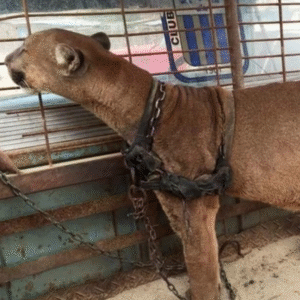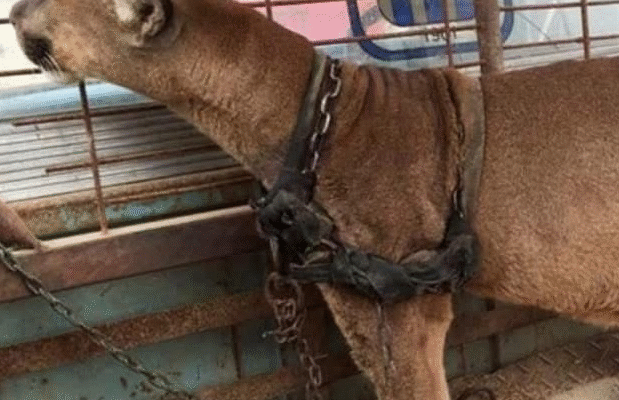Lion Spends 20 Years in Captivity — Watch His Heartwarming Reaction to Freedom
For two long decades, a lion named Ruben knew nothing but the cold, confining walls of a cage. He was born in captivity, raised behind iron bars, and never once felt the grass beneath his paws or the sun warming his mane. His world was measured in the few steps he could take from one end of the cage to the other. Day after day, the sounds of laughter and camera clicks echoed around him as visitors passed by, unaware that the majestic animal before them had been stripped of everything that made him a king.
When the circus that owned him finally closed, all the other animals were rescued and rehomed. But Ruben was left behind—forgotten. The trucks drove away, the lights went out, and silence settled over the abandoned site. He was the last lion in Armenia, locked away in a crumbling cage with no one to care for him. His roar, once fierce, had faded into a hollow whisper. But fate had other plans for him.
The Lonely Years
For twenty years, Ruben’s life was defined by loneliness. He lived in a tiny enclosure barely larger than a parking space, surrounded by rusted bars and cracked concrete. There were no trees, no shade, no other lions to keep him company. The once-mighty predator became frail and weak. His muscles atrophied from disuse, his mane thinned, and his paws bore the marks of years spent pacing on hard floors.
Caretakers who visited said his eyes told the story of his suffering—eyes that had seen too much captivity, too much neglect. He had forgotten what freedom looked like, what open space felt like, what it meant to be wild.
A Ray of Hope
Then, one day, word of his existence reached the ears of Animal Defenders International (ADI), an organization known for rescuing animals from circuses and captivity around the world. When they learned about Ruben, they knew they couldn’t leave him behind. But rescuing him wouldn’t be easy.
The old cage stood on a desolate property, and moving a lion who hadn’t walked freely in decades was risky. His health was fragile, and every step of the journey would have to be planned with precision. Still, the team was determined. They prepared a reinforced transport crate, arranged medical staff, and secured permission to move him from Armenia to a wildlife sanctuary in South Africa—the land where lions truly belong.
When rescuers arrived, Ruben was cautious. He watched them with tired eyes, unsure whether these humans meant harm or help. But as they gently approached, speaking softly, offering food, and opening the crate, something inside him seemed to awaken. For the first time in years, he saw a glimmer of possibility—an open door leading to a different kind of life.
The Journey Home
The trip spanned thousands of miles and several countries. Ruben was sedated for part of the journey to reduce stress, and veterinarians monitored his vital signs constantly. Each bump of the road, each hum of the airplane engines, brought him closer to a freedom he could not yet imagine.
When the plane finally touched down in South Africa, rescuers could barely contain their emotions. “Welcome home, Ruben,” one whispered as they opened the transport crate under the African sun.
The First Step of Freedom
At first, Ruben hesitated. After twenty years in confinement, the open air seemed foreign, even frightening. He peeked out, blinking against the bright sunlight, his nose twitching at the scent of fresh earth and grass. Then, slowly, he stepped forward. One paw. Then another.
For the first time in his life, he felt soft soil beneath his feet. The wind brushed against his mane. The sounds of birds and distant lions filled the air. He took a deep breath, lifted his head, and let out a low, uncertain rumble—a voice that had almost been lost to silence.
Witnesses say what happened next brought everyone to tears. Ruben, the forgotten lion, began to roar. It was shaky at first, as if his voice had to remember what power felt like. But soon it grew stronger, deeper, echoing across the sanctuary. It was not a roar of anger, but of life—a declaration that he was still here, still proud, still a king.
A New Beginning
In his new home at the LIONSROCK Big Cat Sanctuary, Ruben received medical care, proper food, and, most importantly, space to move. The staff designed a special enclosure for him with ramps, soft terrain, and shady trees to help him rebuild strength.
For weeks, he spent hours exploring his surroundings—sniffing plants, basking in the sun, and watching the horizon. His once dull coat began to shine again, and the tiredness in his eyes gave way to curiosity. Though his muscles remained weak, each day brought new progress.
Caretakers describe him as gentle and intelligent, often responding to their voices with soft rumbles of recognition. They say he loves lying under the sun, his face tilted upward as if soaking in every ounce of the freedom he was denied for so long.
The Symbol of Hope
Ruben’s story quickly spread across social media, capturing hearts worldwide. People were moved not only by his suffering but by his strength—the way he endured years of isolation and still found the courage to embrace life again. His first roar in freedom became a symbol of resilience and hope for all animals who suffer in silence.
Wildlife experts emphasize that his case sheds light on a much bigger issue: the exploitation of wild animals in entertainment. For every Ruben, there are countless others still trapped behind bars, waiting for a second chance. His rescue stands as a reminder that compassion and action can rewrite even the most heartbreaking stories.
A Roar That Echoes Beyond
Today, Ruben lives peacefully in South Africa, surrounded by open fields and the distant calls of other lions. He is too old to be released into the wild, but within the safety of the sanctuary, he has everything he needs—freedom, care, and dignity.
Each morning, he greets the sunrise with a low, contented rumble. Sometimes, he gazes at the horizon for hours, as if remembering the long years of darkness and appreciating the light even more. Visitors who see him often say the same thing: “He looks like he knows he’s finally home.”
The Lesson of Ruben’s Life
Ruben’s story teaches us that freedom is not just a condition—it’s a birthright. Even after twenty years in captivity, his spirit wasn’t broken; it was only waiting for the right moment to rise again. His journey from isolation to liberation reminds us that every living being—whether human or animal—deserves the chance to live with dignity, to move, to breathe, and to feel the sun on their skin.
For the rescuers, the sound of Ruben’s first roar will forever echo in their hearts. It was more than a sound—it was the voice of forgiveness, strength, and renewal.
And for the world, his story serves as a message of hope: no matter how long the darkness lasts, the moment freedom arrives, life begins anew.


